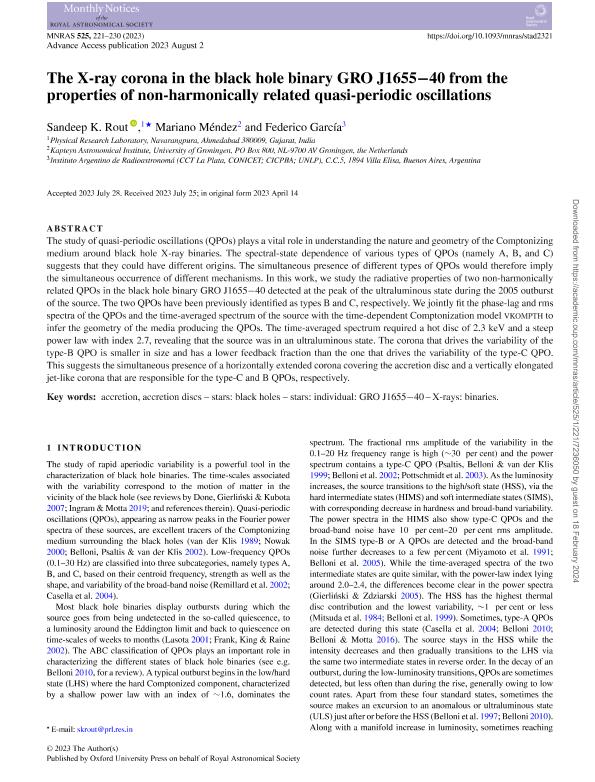Mostrar el registro sencillo del ítem
dc.contributor.author
Rout, Sandeep K.
dc.contributor.author
Méndez, Mariano
dc.contributor.author
García, Federico

dc.date.available
2024-03-22T13:39:25Z
dc.date.issued
2023-10
dc.identifier.citation
Rout, Sandeep K.; Méndez, Mariano; García, Federico; The X-ray corona in the black hole binary GRO J1655-40 from the properties of non-harmonically related quasi-periodic oscillations; Wiley Blackwell Publishing, Inc; Monthly Notices of the Royal Astronomical Society; 525; 1; 10-2023; 221-230
dc.identifier.issn
0035-8711
dc.identifier.uri
http://hdl.handle.net/11336/231315
dc.description.abstract
The study of quasi-periodic oscillations (QPOs) plays a vital role in understanding the nature and geometry of the Comptonizing medium around black hole X-ray binaries. The spectral-state dependence of various types of QPOs (namely A, B, and C) suggests that they could have different origins. The simultaneous presence of different types of QPOs would therefore imply the simultaneous occurrence of different mechanisms. In this work, we study the radiative properties of two non-harmonically related QPOs in the black hole binary GRO J1655-40 detected at the peak of the ultraluminous state during the 2005 outburst of the source. The two QPOs have been previously identified as types B and C, respectively. We jointly fit the phase-lag and rms spectra of the QPOs and the time-averaged spectrum of the source with the time-dependent Comptonization model vkompth to infer the geometry of the media producing the QPOs. The time-averaged spectrum required a hot disc of 2.3 keV and a steep power law with index 2.7, revealing that the source was in an ultraluminous state. The corona that drives the variability of the type-B QPO is smaller in size and has a lower feedback fraction than the one that drives the variability of the type-C QPO. This suggests the simultaneous presence of a horizontally extended corona covering the accretion disc and a vertically elongated jet-like corona that are responsible for the type-C and B QPOs, respectively.
dc.format
application/pdf
dc.language.iso
eng
dc.publisher
Wiley Blackwell Publishing, Inc

dc.rights
info:eu-repo/semantics/openAccess
dc.rights.uri
https://creativecommons.org/licenses/by-nc-sa/2.5/ar/
dc.subject
ACCRETION
dc.subject
ACCRETION DISCS - STARS: BLACK HOLES - STARS: INDIVIDUAL: GRO J1655-40
dc.subject
X-RAYS: BINARIES
dc.subject.classification
Astronomía

dc.subject.classification
Ciencias Físicas

dc.subject.classification
CIENCIAS NATURALES Y EXACTAS

dc.title
The X-ray corona in the black hole binary GRO J1655-40 from the properties of non-harmonically related quasi-periodic oscillations
dc.type
info:eu-repo/semantics/article
dc.type
info:ar-repo/semantics/artículo
dc.type
info:eu-repo/semantics/publishedVersion
dc.date.updated
2024-02-28T14:24:13Z
dc.journal.volume
525
dc.journal.number
1
dc.journal.pagination
221-230
dc.journal.pais
Reino Unido

dc.description.fil
Fil: Rout, Sandeep K.. Physical Research Laboratory India; India
dc.description.fil
Fil: Méndez, Mariano. University of Groningen; Países Bajos
dc.description.fil
Fil: García, Federico. Provincia de Buenos Aires. Gobernación. Comisión de Investigaciones Científicas. Instituto Argentino de Radioastronomía. Consejo Nacional de Investigaciones Científicas y Técnicas. Centro Científico Tecnológico Conicet - La Plata. Instituto Argentino de Radioastronomía; Argentina
dc.journal.title
Monthly Notices of the Royal Astronomical Society

dc.relation.alternativeid
info:eu-repo/semantics/altIdentifier/doi/http://dx.doi.org/10.1093/mnras/stad2321
dc.relation.alternativeid
info:eu-repo/semantics/altIdentifier/url/https://academic.oup.com/mnras/article/525/1/221/7236050
Archivos asociados
